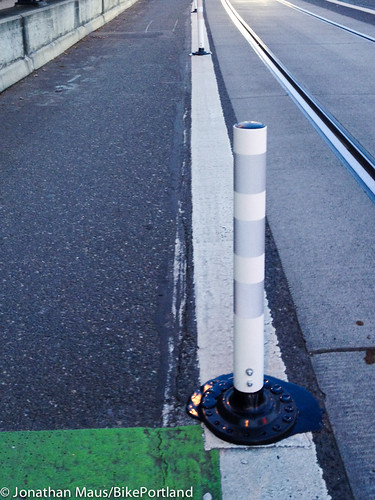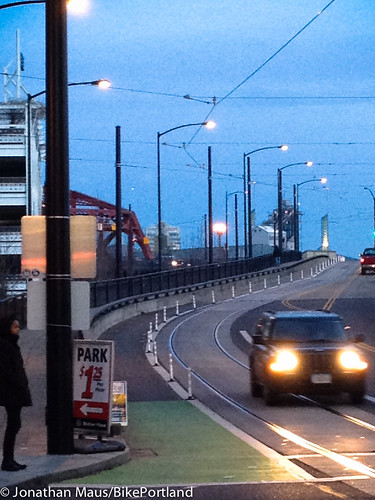
– More photos below –
Remember the track-straddle phenomenon we brought to your attention almost a year ago (and again this past summer)? Well, thanks to new plastic bollards installed by the Portland Bureau of Transportation, it’s not going to happen anymore.

Track-straddling is the term we gave to a puzzling behavior by people driving down (west) NW Lovejoy as it comes off the Broadway Bridge. Newly installed streetcar tracks, placed just a foot or so from an existing bike lane, were causing people to drive inside the bikeway. This behavior was unnerving to say the least and it also caused premature deterioration of the thermoplastic bike lane striping.
Now, I’m happy to report that PBOT has installed a series of plastic bollards along the entire stretch of bike lane on the ramp. The bollards (referred to as “candlesticks” by engineers) create a barrier between auto and bike traffic and they prevent people from driving cars inside the bike lane. Check out more photos below (sorry, all I had was my camera phone)…





At just about two feet high, the bollards are much shorter than ones recently installed on the N Going bike boulevard, and they’re also white instead of orange. They’re placed just over one car length apart. I wasn’t able to get any info from PBOT as they are all out on vacation, but I assume the shorter bollards and their relatively wide spacing is to allow people on bikes to take the lane in order to pass other riders and/or to prepare for a left turn at NW 9th (not everyone likes to do the “Copenhagen left” that PBOT encourages).
The important thing is, they are a sufficient deterrent to driving in the bike lane.
These bollards are just the latest sign that PBOT is doing more to separate modes. It’s an exciting development, and I wonder if it means we’ll see more of this type of bollard use. While full-blown cycle tracks aren’t likely to be popping up everywhere any time soon, there are many places — like on Highway 30 out to Sauvie Island for instance — where the use of bollards could cheaply and simply provide a much safer bicycling environment.
Have you ridden the Lovejoy ramp since these were installed? Please share your feedback.
UPDATE: Seems as though some of the bollards have already been knocked over. Here’s an update from a commenter below:
“I rode past this AM and counted about 8 of them scattered around after being run over.”
UPDATE: Just heard back from PBOT spokesman Dan Anderson:
“PBOT installed “short wands” on the Lovejoy ramp to test whether they discourage people who drive from entering the bike lane. Engineers and the public have seen people who drive move closer to the bike lane and into the lane to avoid driving on the streetcar tracks.
Also, we are aware that many of the short wands have been knocked down. I’ll let you know when conclusions are reached about this experiment and what longer-term actions are planned.”
UPDATE: Well, looks like the experiment needs some tweaking. Here’s how it looks this morning, via a photo by reader David Haines:


